Classification of Cucumber Leaves Based on Nitrogen Content Using the Hyperspectral Imaging Technique and Majority Voting
Abstract
1. Introduction
2. Results
2.1. The Most Effective Wavelengths for the Classification of Cucumber Leaves Based on Nitrogen Content
2.2. Investigation of the Performance of Different Classifiers for the Classification of Cucumber Leaves Based on Nitrogen Content in 200 Iterations
3. Discussion
3.1. Comparison of Mean and Standard Deviation of the ROC and CCR for Effective Wavelength Spectral Data and Entire Data to Identify Cucumber Leaves in Terms of Nitrogen Content
3.2. Comparison of the Results Obtained in This Study with Those of Other Researchers
4. Materials and Methods
4.1. Preparation of the Samples to Perform HyperSpectral Imaginary
4.2. Hardware Required for Classification of Cucumber Plants Based on Nitrogen Content
4.3. Preprocessing of Original Spectral Data
4.4. Selection of the Optimal Wavelength for the Classification of Cucumber Leaves Using Hybrid ANN-BBO
4.5. Measurement of Nitrogen by a Destructive Method
4.6. Classification of Cucumber Plants Based on Nitrogen Content by Majority Voting
4.6.1. Classifier ANN-ICA
4.6.2. Classifier ANN-HS
4.6.3. Classifier K-Nearest-Neighborhood (KNN)
- (1)
- Calling the data
- (2)
- Initial selection of k-value
- (3)
- Developing the classes, repeat from 1 to the total number of training data points:
- (A)
- Calculating the distance of the test data from each row of the training data set by Euclidean distance.
- (B)
- Selection of the top k rows of the sorted array
- (C)
- Receiving the most repetitive classes in these rows
- (D)
- Returning the predicted class value.
4.6.4. Classifier Linear Discrimination Analysis (LDA)
4.6.5. Classifier Radial Basis Function (RBF)
4.7. Assessment of Performance of the MV Classifier
5. Conclusions
Author Contributions
Funding
Institutional Review Board Statement
Informed Consent Statement
Data Availability Statement
Conflicts of Interest
References
- Bryk, T.; Zalzstein, E.; Lifshitz, M. Methemoglobinemia induced by refrigerated vegetable puree in conjunction with supraventricular tachycardia. Acta Paediatr. 2007, 92, 1214–1215. [Google Scholar] [CrossRef]
- Salimi, M.; Pourdarbani, R.; Nouri, B.A. Factors Affecting the Adoption of Agricultural Automation Using Davis’s Acceptance Model (Case Study: Ardabil). Acta Technol. Agric. 2020, 23, 30–39. [Google Scholar] [CrossRef]
- Pourdarbani, R.; Sabzi, S.; García-Amicis, V.M.; García-Mateos, G.; Molina-Martínez, J.M.; Ruiz-Canales, A. Automatic Classification of Chickpea Varieties Using Computer Vision Techniques. Agronomy 2019, 9, 672. [Google Scholar] [CrossRef]
- Sabzi, S.; Pourdarbani, R.; Kalantari, D.; Panagopoulos, T. Designing a Fruit Identification Algorithm in Orchard Conditions to Develop Robots Using Video Processing and Majority Voting Based on Hybrid Artificial Neural Network. Appl. Sci. 2020, 10, 383. [Google Scholar] [CrossRef]
- Pourdarbani, R.; Rezaei, B. Automatic detection of greenhouse plants pests by image analysis. Tarım Makinaları Bilimi Dergisi 2011, 7, 171–174. [Google Scholar]
- Wu, D.; Sun, D.-W. Advanced applications of hyperspectral imaging technology for food quality and safety analysis and assessment: A review—Part I: Fundamentals. Innov. Food Sci. Emerg. Technol. 2013, 19, 1–14. [Google Scholar] [CrossRef]
- Lorente, D.; Aleixos, N.; Gomezsanchis, J.; Cubero, S.; García-Navarrete, O.L.; Blasco, J. Recent Advances and Applications of Hyperspectral Imaging for Fruit and Vegetable Quality Assessment. Food Bioprocess Technol. 2012, 5, 1121–1142. [Google Scholar] [CrossRef]
- Leiva-Valenzuela, G.A.; Lu, R.; Aguilera, J.M. Prediction of firmness and soluble solids content of blueberries using hyperspectral reflectance imaging. J. Food Eng. 2013, 115, 91–98. [Google Scholar] [CrossRef]
- Cen, H.; Lu, R.; Mendoza, F.A.; Ariana, D.P. Assessing Multiple Quality Attributes of Peaches Using Optical Absorption and Scattering Properties. Trans. ASABE 2012, 55, 647–657. [Google Scholar] [CrossRef]
- Chen, H.C.; Chen, X.D.; Lu, Q.P. BP-ANN Application to the Model Establishment of Determination Wheat Protein Using Near Infrared Spectroscopy. J. Physics: Conf. Ser. 2006, 48, 29–35. [Google Scholar] [CrossRef]
- Zhang, B.; Yang, W.; Gao, L.; Chen, N. Real-time target detection in hyperspectral images based on spatial-spectral information extraction. EURASIP J. Adv. Signal Process. 2012, 2012, 142. [Google Scholar] [CrossRef]
- Esquerre, C.; Gowen, A.; Downey, G.; O’Donnell, C.; Fernandez, C.A.E. Wavelength selection for development of a near infrared imaging system for early detection of bruise damage in mushrooms (Agaricus bisporus). J. Near Infrared Spectrosc. 2012, 20, 537. [Google Scholar] [CrossRef]
- Huang, M.; Lu, R. Apple mealiness detection using hyperspectral scattering technique. Postharvest Biol. Technol. 2010, 58, 168–175. [Google Scholar] [CrossRef]
- Huang, M.; Zhu, Q. Feature extraction of hyperspectral scattering image for apple mealiness based on singular value decomposition. Spectrosc. Spectr. Anal. 2011, 31, 767–770. [Google Scholar] [CrossRef]
- Huang, M.; Zhu, Q.; Wang, B.; Lu, R. Analysis of hyperspectral scattering images using locally linear embedding algorithm for apple mealiness classification. Comput. Electron. Agric. 2012, 89, 175–181. [Google Scholar] [CrossRef]
- Jarolmasjed, S.; Khot, L.R.; Sankaran, S. Hyperspectral Imaging and Spectrometry-Derived Spectral Features for Bitter Pit Detection in Storage Apples. Sensors 2018, 18, 1561. [Google Scholar] [CrossRef] [PubMed]
- Li, B.; Cobo-Medina, M.; Lecourt, J.; Harrison, N.; Harrison, R.J.; Cross, J.V. Application of hyperspectral imaging for nondestructive measurement of plum quality attributes. Postharvest Biol. Technol. 2018, 141, 8–15. [Google Scholar] [CrossRef]
- Huang, Y.; Lu, R.; Hu, D.; Chen, K. Quality assessment of tomato fruit by optical absorption and scattering properties. Postharvest Biol. Technol. 2018, 143, 78–85. [Google Scholar] [CrossRef]
- Orrillo, I.; Cruz-Tirado, J.; Cardenas, A.; Oruna, M.; Carnero, A.; Barbin, D.F.; Siche, R. Hyperspectral imaging as a powerful tool for identification of papaya seeds in black pepper. Food Control. 2019, 101, 45–52. [Google Scholar] [CrossRef]
- Dacal-Nieto, A.; Formella, A.; Carrión, P.; Vázquez-Fernández, E.; Fernández-Delgado, M. Non–destructive Detection of Hollow Heart in Potatoes Using Hyperspectral Imaging. Lect. Notes Comput. Sci. 2011, 6855, 180–187. [Google Scholar]
- Williams, P.J.; Manley, M.; Fox, G.; Geladi, P. Indirect Detection of Fusarium Verticillioidesin Maize (Zea mays L.) Kernels by near Infrared Hyperspectral Imaging. J. Near Infrared Spectrosc. 2010, 18, 49–58. [Google Scholar] [CrossRef]
- Sabzi, S.; Pourdarbani, R.; Rohban, M.; García-Mateos, G.; Paliwal, J.; Molina-Martínez, J. Early Detection of Excess Nitrogen Consumption in Cucumber Plants Using Hyperspectral Imaging Based on Hybrid Neural Networks and the Imperialist Competitive Algorithm. Agronomy 2021, 11, 575. [Google Scholar] [CrossRef]
- Chen, S.; Hu, T.; Luo, L.; He, Q.; Zhang, S.; Li, M.; Cui, X.; Li, H. Rapid estimation of leaf nitrogen content in apple-trees based on canopy hyperspectral reflectance using multivariate methods. Infrared Phys. Technol. 2020, 111, 103542. [Google Scholar] [CrossRef]
- Xie, C.; Yang, C.; He, Y. Hyperspectral imaging for classification of healthy and gray mold diseased tomato leaves with different infection severities. Comput. Electron. Agric. 2017, 135, 154–162. [Google Scholar] [CrossRef]
- Xia, J.; Cao, H.; Yang, Y.; Zhang, W.; Wan, Q.; Xu, L.; Ge, D.; Zhang, W.; Ke, Y.; Huang, B. Detection of waterlogging stress based on hyperspectral images of oilseed rape leaves (Brassica napus L.). Comput. Electron. Agric. 2019, 159, 59–68. [Google Scholar] [CrossRef]
- Zhang, M.; Qin, Z.; Liu, X.; Ustin, S.L. Detection of stress in tomatoes induced by late blight disease in California, USA, using hyperspectral remote sensing. Int. J. Appl. Earth Obs. Geoinf. 2003, 4, 295–310. [Google Scholar] [CrossRef]
- Xing, J.; De Baerdemaeker, J. Bruise detection on ‘Jonagold’ apples using hyperspectral imaging. Postharvest Biol. Technol. 2005, 37, 152–162. [Google Scholar] [CrossRef]
- Rossel, R.A.; McBratney, A.B. Diffuse reflectance spectroscopy as a tool for digital soil mapping. In Digital Soil Mapping with Limited Data; Mc Bratney, A.B., Hartemink, A.E., Mendonça-Santos, L., Eds.; Developments in Soil Science Series; Elsevier: Amsterdam, The Netherlands, 2008. [Google Scholar]
- Atashpaz-Gargari, E.; Lucas, C. Imperialist competitive algorithm: An algorithm for optimization inspired by imperialistic competition. In Proceedings of the 2007 IEEE Congress on Evolutionary Computation, Singapore, 25–28 September 2007. [Google Scholar] [CrossRef]
- Simon, D.; Ergezer, M.; Du, D. Population distributions in biogeography-based optimization algorithms with elitism. In Proceedings of the 2009 IEEE International Conference on Systems, Man and Cybernetics, San Antonio, TX, USA, 11–14 October 2009; IEEE: Piscataway, NJ, USA, 2009; pp. 991–996. [Google Scholar]
- Anuthama, K.; Shankar, S.; Ilayaraja, V.; Kumar, G.S.; Rajmohan, M. Vignesh Determining dental sex dimorphism in South Indians using discriminant function analysis. Forensic Sci. Int. 2011, 212, 86–89. [Google Scholar] [CrossRef]
- Pourdarbani, R.; Sabzi, S.; Kalantari, D.; Karimzadeh, R.; Ilbeygi, E.; Arribas, J.I. Automatic non-destructive video estimation of maturation levels in Fuji apple (Malus Malus pumila) fruit in orchard based on colour (Vis) and spectral (NIR) data. Biosyst. Eng. 2020, 195, 136–151. [Google Scholar] [CrossRef]
- Alibaba, M.; Pourdarbani, R.; Manesh, M.H.K.; Ochoa, G.V.; Forero, J.D. Thermodynamic, exergo-economic and exergo-environmental analysis of hybrid geothermal-solar power plant based on ORC cycle using emergy concept. Heliyon 2020, 6, e03758. [Google Scholar] [CrossRef] [PubMed]
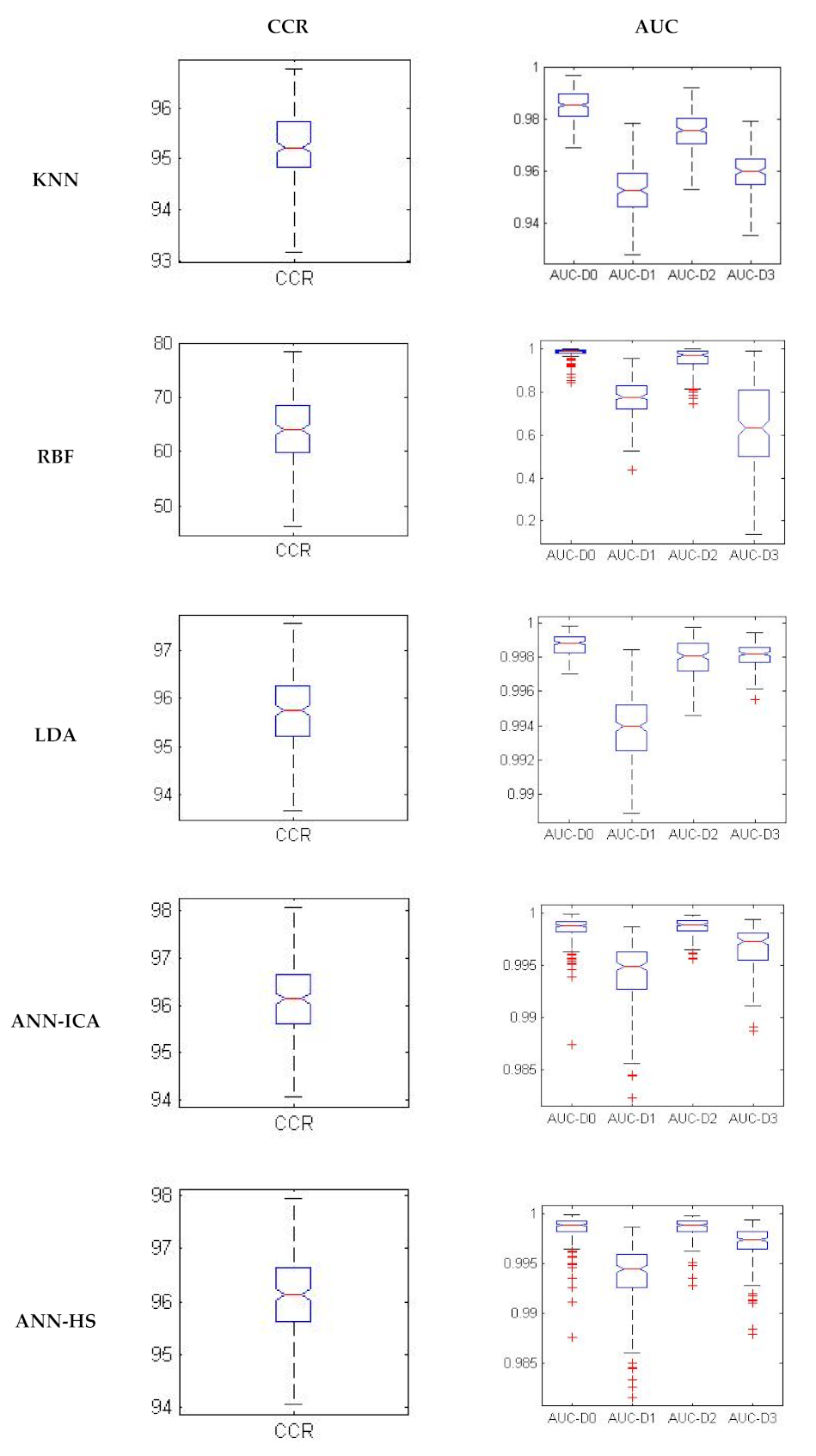
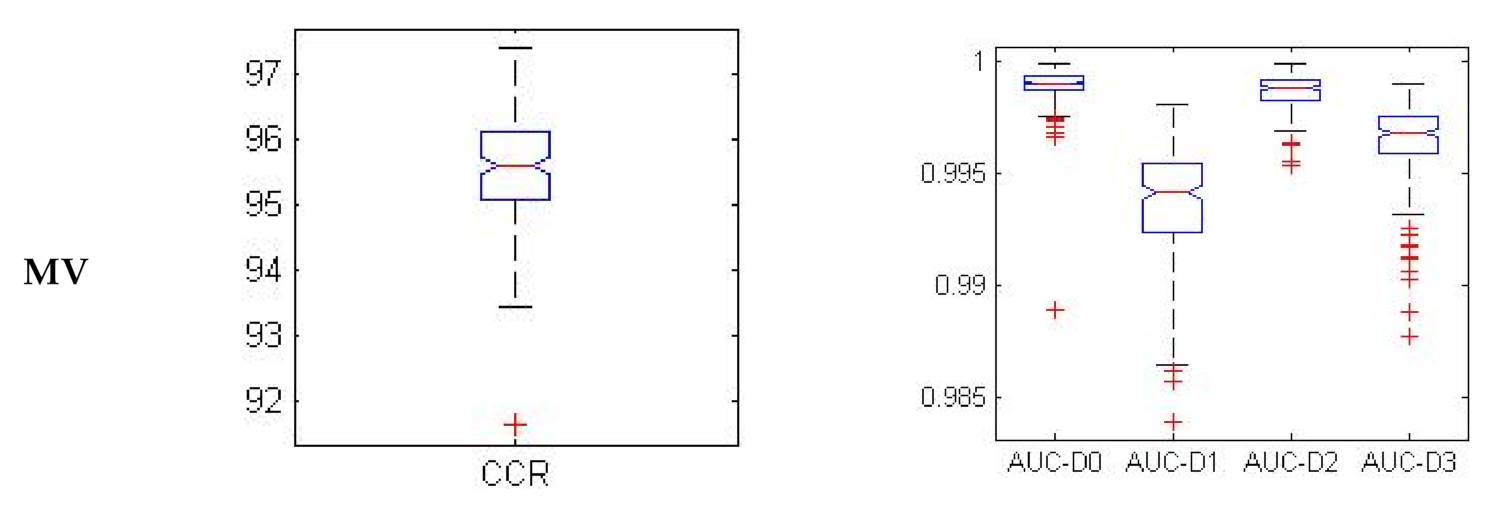
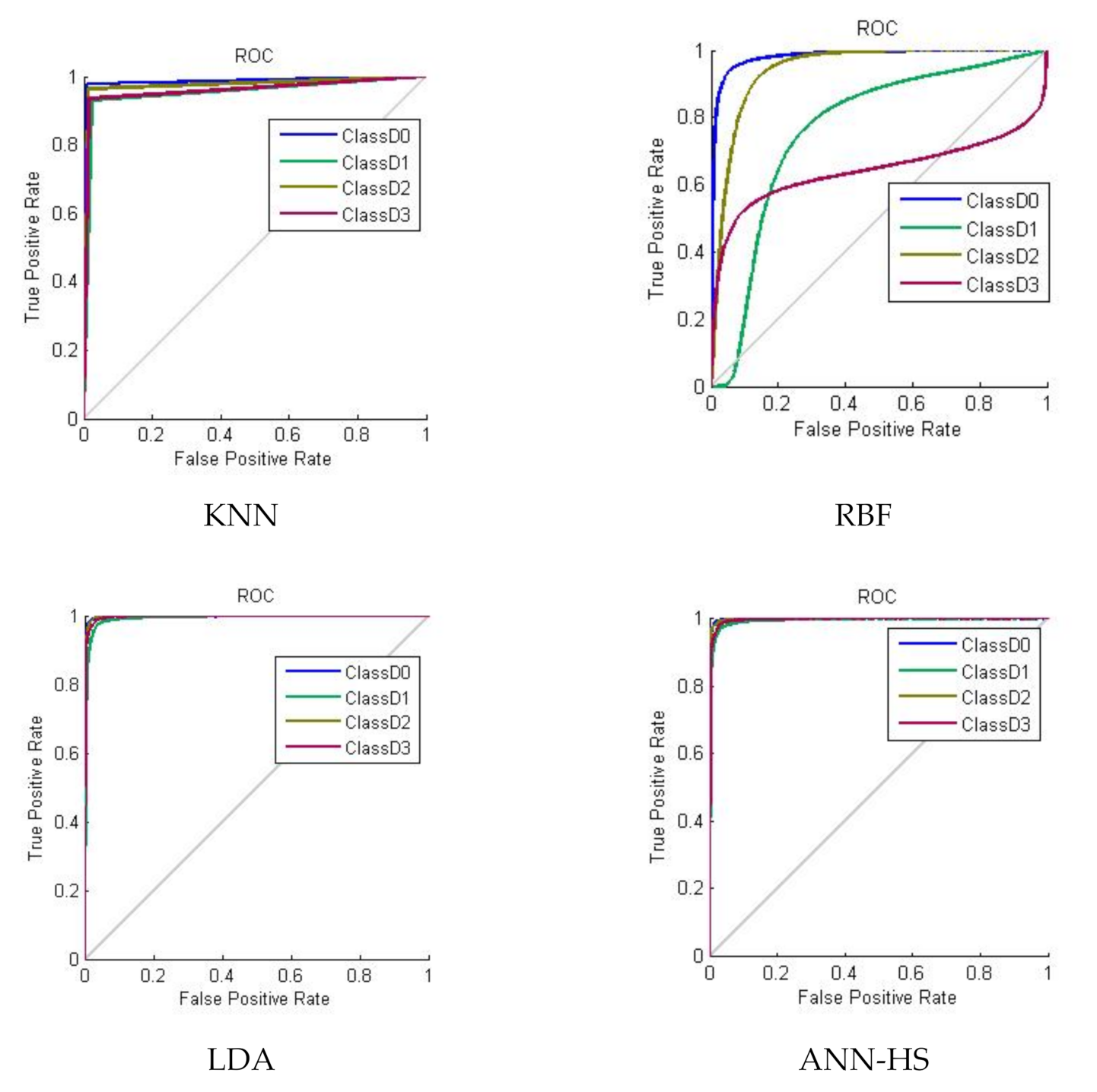
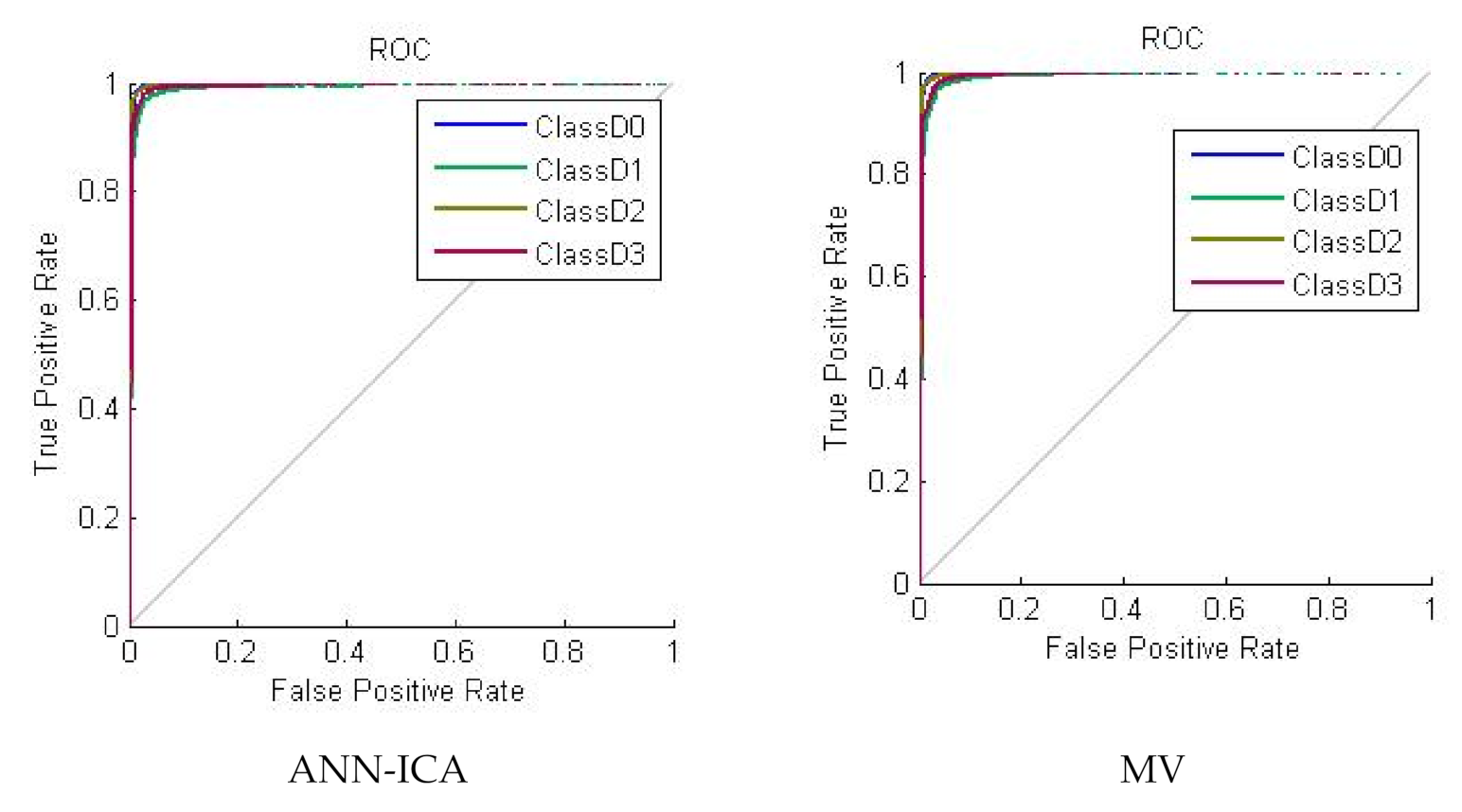
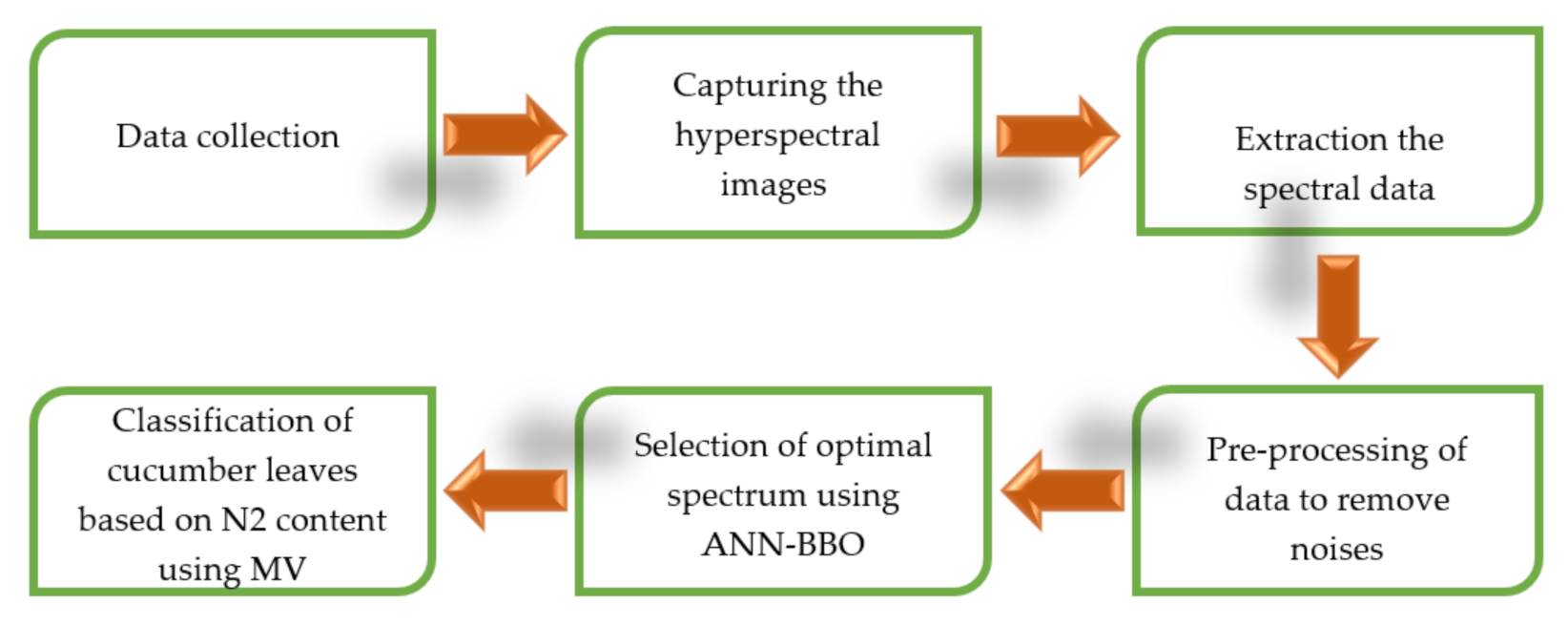
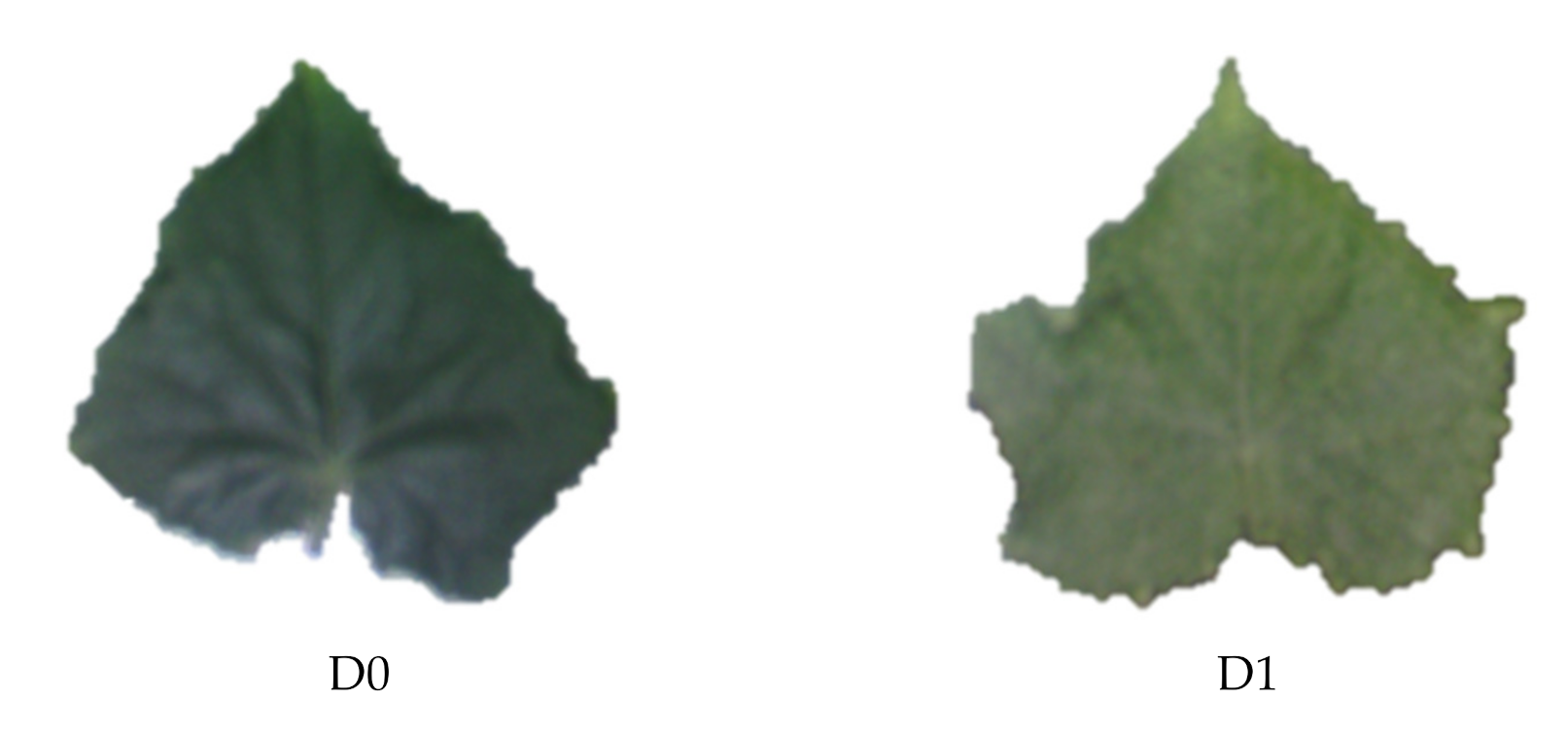
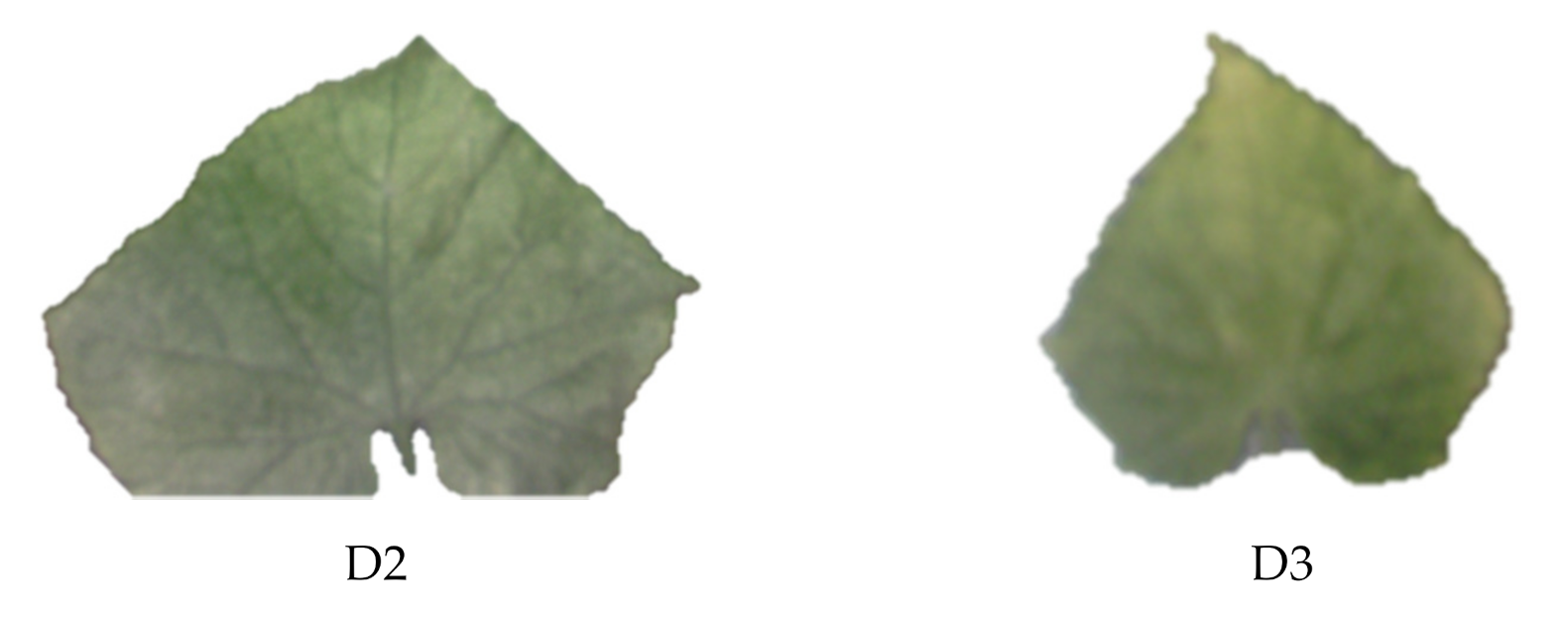
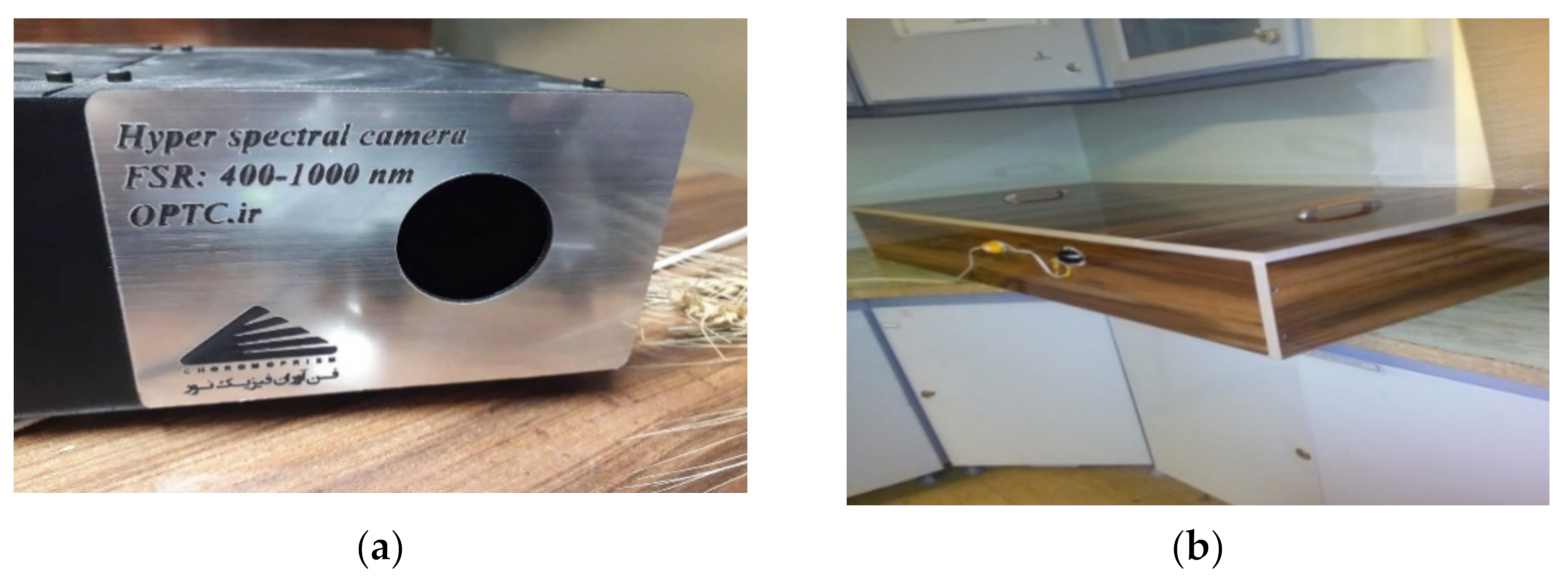
| Methods | Classes | D0 | D1 | D2 | D3 | Total Data | Misclassified (%) | CCR. |
|---|---|---|---|---|---|---|---|---|
| KNN | D0 | 44,872 | 948 | 0 | 0 | 45,820 | 2.11 | 95.24 |
| D1 | 1013 | 40,091 | 768 | 1229 | 43,101 | 7.5 | ||
| D2 | 0 | 430 | 29,490 | 695 | 30,615 | 3.81 | ||
| D3 | 0 | 1519 | 773 | 33,172 | 35,464 | 6.9 | ||
| RBF | D0 | 24,241 | 16,740 | 2950 | 1889 | 45,820 | 89.01 | 64.03 |
| D1 | 169 | 36,072 | 4155 | 2705 | 43,101 | 19.48 | ||
| D2 | 0 | 3168 | 26,837 | 610 | 30,615 | 14.07 | ||
| D3 | 14 | 17,809 | 5543 | 12,098 | 35,464 | 193.13 | ||
| LDA | D0 | 43,703 | 1751 | 366 | 0 | 45,820 | 4.84 | 95.73 |
| D1 | 673 | 40,845 | 266 | 1317 | 43,101 | 5.52 | ||
| D2 | 0 | 395 | 29,744 | 476 | 30,615 | 2.92 | ||
| D3 | 0 | 458 | 904 | 34,102 | 35,464 | 3.99 | ||
| ANN-ICA | D0 | 44,794 | 997 | 29 | 0 | 45,820 | 2.29 | 96.14 |
| D1 | 1087 | 40,926 | 133 | 955 | 43,101 | 5.31 | ||
| D2 | 0 | 610 | 29,596 | 409 | 30,615 | 3.44 | ||
| D3 | 0 | 915 | 846 | 33,703 | 35,464 | 5.22 | ||
| ANN-HS | D0 | 44,872 | 899 | 49 | 0 | 45,820 | 2.11 | 96.11 |
| D1 | 1079 | 40,914 | 151 | 957 | 43,101 | 5.34 | ||
| D2 | 1 | 617 | 29,581 | 416 | 30,615 | 3.49 | ||
| D3 | 0 | 1008 | 847 | 33,609 | 35,464 | 5.51 | ||
| MV | D0 | 44,566 | 1157 | 96 | 1 | 45,820 | 2.81 | 95.55 |
| D1 | 1094 | 40,965 | 132 | 910 | 43,101 | 5.21 | ||
| D2 | 8 | 714 | 29,486 | 407 | 30,615 | 3.82 | ||
| D3 | 0 | 1580 | 788 | 33,096 | 35,464 | 7.15 |
| Methods | Classes | Recall (%) | Accuracy (%) | Specificity (%) | Precision (%) | F (%) |
|---|---|---|---|---|---|---|
| KNN | D0 | 97.79231 | 98.68905 | 99.08583 | 97.93103 | 97.86162 |
| D1 | 93.26091 | 96.15259 | 97.2771 | 93.0164 | 93.1385 | |
| D2 | 95.034 | 98.22611 | 99.05668 | 96.32533 | 95.67531 | |
| D3 | 94.51789 | 97.22341 | 98.03675 | 93.53711 | 94.02494 | |
| RBF | D0 | 99.25074 | 82.01636 | 77.65825 | 52.90485 | 69.01942 |
| D1 | 48.88534 | 68.92509 | 89.98789 | 83.69179 | 61.71957 | |
| D2 | 67.96758 | 85.79975 | 95.04128 | 87.65964 | 76.56776 | |
| D3 | 69.92255 | 77.64791 | 78.85736 | 34.11347 | 45.85529 | |
| LDA | D0 | 98.48341 | 98.15457 | 98.01794 | 95.37975 | 96.90674 |
| D1 | 94.00677 | 96.82879 | 97.94545 | 94.76578 | 94.38475 | |
| D2 | 95.08951 | 98.40386 | 99.27126 | 97.15499 | 96.11116 | |
| D3 | 95.00488 | 97.91817 | 98.82235 | 96.15949 | 95.57869 | |
| ANN-ICA | D0 | 97.63083 | 98.60188 | 99.02519 | 97.7608 | 97.69577 |
| D1 | 94.19536 | 96.94436 | 98.02753 | 94.95371 | 94.57302 | |
| D2 | 96.70631 | 98.65802 | 99.15395 | 96.67157 | 96.68894 | |
| D3 | 96.1103 | 97.94602 | 98.49586 | 95.0344 | 95.56932 | |
| ANN-HS | D0 | 97.64972 | 98.65699 | 99.09759 | 97.93103 | 97.79018 |
| D1 | 94.18942 | 96.93468 | 98.01631 | 94.92587 | 94.55621 | |
| D2 | 96.58156 | 98.62237 | 99.1414 | 96.62257 | 96.60206 | |
| D3 | 96.07512 | 97.87916 | 98.41753 | 94.76934 | 95.41777 | |
| MV | D0 | 97.58693 | 98.43423 | 98.80345 | 97.2632 | 97.4248 |
| D1 | 92.23028 | 96.365 | 98.04546 | 95.0442 | 93.6161 | |
| D2 | 96.66907 | 98.57246 | 99.05725 | 96.31227 | 96.49034 | |
| D3 | 96.17016 | 97.57179 | 97.98271 | 93.32281 | 94.72509 |
| MV Method | CCR | AUCD0 | AUCD1 | AUCD2 | AUCD3 | |
|---|---|---|---|---|---|---|
| Effective wavelength | Mean | 95.55 | 0.998 | 0.993 | 0.996 | 0.995 |
| SD | 0.7725 | 0.0009 | 0.0023 | 0.0007 | 0.0017 | |
| Entire wavelength | Mean | 96.14 | 0.998 | 0.994 | 0.998 | 0.996 |
| SD | 0.0705 | 0.0013 | 0.0029 | 0.0008 | 0.00020 |
| Statistical Charactreistic | Value |
|---|---|
| Mean | −1.180 × 10−1 |
| Std. Deviation | 0.26381678 |
| t-Value | −1.001 |
| Degree of Freedom | 4 |
| Significance | 0.374 ns |
| Researchers | Product Type | Early Detection Type | CCR (%) |
|---|---|---|---|
| Proposed method | Cucumber | Excess nitrogen | 95.55 |
| (Xie et al. [24]) | Tomato | Gray mold disease | 94.44 |
| (Xia et al. [25]) | oilseed rape | waterlogging stress | 94.44 |
| (Zhang et al. [26]) | Tomato | Stress | 90 |
| (Xing. & Baerdemaeker [27]) | Apple | Bruise | 93 |
| Parameter | Spesification |
|---|---|
| Number of Neurons | 18 & 16 |
| Number of Layers | 2 |
| Transfer Function | poslin, softmax |
| Back Propagation Network Training Function | trainbr |
| Back Propagation Weight/Bias Learning Function | learnp |
| Equations | Description |
|---|---|
| How many samples are correctly detected | |
| How many correctly detected outputs are actually correct | |
| Total correct classification | |
| How many samples are incorrectly detected | |
| Recall and precision harmonic weighted average | |
| Receiver operational curve (ROC) | |
| TP: True Positive | FP: False Positive |
| TN: True Negative | FN: False Negative |
Publisher’s Note: MDPI stays neutral with regard to jurisdictional claims in published maps and institutional affiliations. |
© 2021 by the authors. Licensee MDPI, Basel, Switzerland. This article is an open access article distributed under the terms and conditions of the Creative Commons Attribution (CC BY) license (https://creativecommons.org/licenses/by/4.0/).
Share and Cite
Sabzi, S.; Pourdarbani, R.; Rohban, M.H.; Fuentes-Penna, A.; Hernández-Hernández, J.L.; Hernández-Hernández, M. Classification of Cucumber Leaves Based on Nitrogen Content Using the Hyperspectral Imaging Technique and Majority Voting. Plants 2021, 10, 898. https://doi.org/10.3390/plants10050898
Sabzi S, Pourdarbani R, Rohban MH, Fuentes-Penna A, Hernández-Hernández JL, Hernández-Hernández M. Classification of Cucumber Leaves Based on Nitrogen Content Using the Hyperspectral Imaging Technique and Majority Voting. Plants. 2021; 10(5):898. https://doi.org/10.3390/plants10050898
Chicago/Turabian StyleSabzi, Sajad, Razieh Pourdarbani, Mohammad Hossein Rohban, Alejandro Fuentes-Penna, José Luis Hernández-Hernández, and Mario Hernández-Hernández. 2021. "Classification of Cucumber Leaves Based on Nitrogen Content Using the Hyperspectral Imaging Technique and Majority Voting" Plants 10, no. 5: 898. https://doi.org/10.3390/plants10050898
APA StyleSabzi, S., Pourdarbani, R., Rohban, M. H., Fuentes-Penna, A., Hernández-Hernández, J. L., & Hernández-Hernández, M. (2021). Classification of Cucumber Leaves Based on Nitrogen Content Using the Hyperspectral Imaging Technique and Majority Voting. Plants, 10(5), 898. https://doi.org/10.3390/plants10050898








